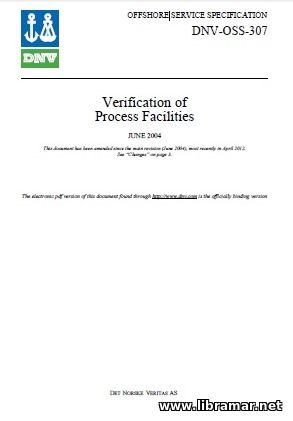 The present OSS was released by DNV with the intention to provide necessary criteria for and proper guidance on verification of due integrity and proper function of various parts/phases of the process facilities. This document falls under the DNV-OSS-300 called Risk Based Verification. All descriptions used within this OSS are corresponding to the simplified verification planning as per Section 2F of Risk Based Verification.
When using the combined or advanced planning, the above stated descriptions will give starting points as well as good references. The ultimate purpose of the present offshore specification was to describe the process of preparation of a verification plan using the risk differentiated levels of associated activities developed by DNV as well as detailed example scopes of work tables, reporting and implementation of the verification plan. This OSS may be adopted, if necessary, for the verification of parts of selected project phases or process facilities.
The process facilities usually comprise the process safety functions, utility systems, HVAC systems and piping, pressure relieving devices, active/passive fire protection systems, shutdown systems, pressure vessels outside the scope of this OSS. HIIS system, flare and blowdown system, various process equipment, classification of the hazardous area, fire and gas detection arrangements etc.
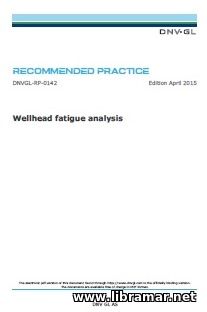 This Recommended Practice RP-0142 was developed and published by DNV GL class society and addresses the wellhead fatigue analysis; it is based on the ongoing Structural Well Integrity Joint Industry Project (JIP) initiated in 2010. The content of this recommended practice primarily bases on the input that was received from the participants and the service provider SES, i.e. Stress Engineering Services Inc., as well as contributions from this class society.
The present document has been developed during regular project meetings and workshops that involved individuals from the participants, DNV GL and external service providers. In case consensus has not been achievable, DNV GL has sought to provide acceptable compromises. Over recent decades, the complexity and duration of offshore drilling activities has steadily increased. Additionally, equipment sizes like subsea BOP stack have grown significantly. These factors have inevitably led to the significant increase of fatigue loads that the wellhead/casing system experience.
The main body of the document provides operational and system description and information on system modeling and response. The appendices contain listings of inputs required for the wellhead fatigue analysis and flow charts with the examples of WFA methods.
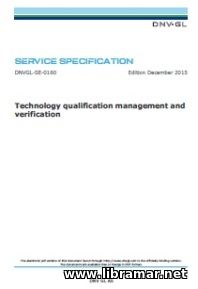 The present service description document was prepared and published by DNV GL to supersede the previous DNV-DSS-401 that described services denoted Technology qualification management offered by DNV GL. This new service specification describes a performance-based end-to-end service offering from early planning through to verification of deliveries, their use in operations and their cessation of use, the connection between the services for technology qualification and verification of technical functionality as provided by DNV GL, and involvement required by DNV GL depending on the requested service and the pertinent project phase.
Focus of this document is placed on the transactions and hand-overs for which technology qualification and verification of technical functionality is needed when planning is completed and specifications are handed over to a supplier that takes responsibility for delivery, at delivery when responsibility for the delivery is handed over to the operator or another recipient, and when operations cease and responsibility is handed over to an internal or external recipient for discontinuing the operations in a responsible manner.
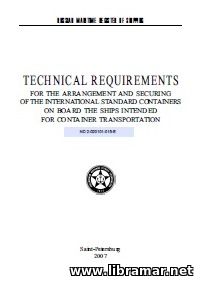 The Russian Register carries out technical supervision based on the present Technical Requirements addressing the arrangement and securing of the international standard containers on board the vessels that are intended for transportation of the container, as well as supervision of containers securing devices.
Performance of the present TR is mandatory for the ships having in their Classification Certificate as required by 2.3.1, Part I "Classification" of the Rules for Sea-Going Ships an additional characteristic stating that the ship is intended for containers transportation, and is also mandatory for container ships carrying containers on the open deck. The present TR apply to the vessels of unrestricted area of navigation and restricted area of navigation R1. Degree of reduction of the said requirements for the ships of restricted area of navigation R2-RSN, R3-RSN and R3 will be subject to special consideration by the Register in each particular case.
The present TR have been developed as applicable to the containers of the ISO series 1 (set forth in the RS Rules for the Construction of Containers). Other types containers securing, again, will be subject to special consideration by the Register taking into consideration their rigidity and strength.
As a rule, fully loaded containers shall be considered. It is permitted to provide containers arrangement and calculate containers securing based on their partial loading. In these cases, the submitted plans of containers arrangement and securing shall specify permissible loading of all containers.
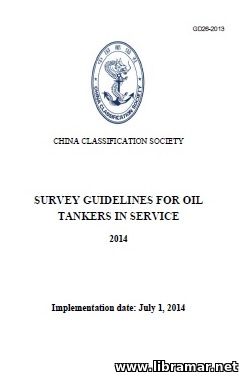 Such ships as the oil tankers are attributed to the high risk type of vessels because of the explosibility and flammability features of their cargoes. Should the oil spill occur on an oil tanker, the ocean circumstance may immediately encounter a very serious pollution. As especially as the tankers become larger, the oil spills occurring after their damage may lead to much greater hazards to the environment.
The present survey guidelines book incorporate the experiences of IACS and Chinese Classification Society in the field of maintenance and inspection of the equipment on oil tankers. These guidelines shall only be applied to self-propelled classed ESP oil tankers in worldwide service, containing integrated cargo tanks. The information contained in these survey guidelines was incorporated based upon all relevant IMO Conventions, IACS URs and applicable CCS Rules in force prior to the September, 2013.
The list of chapters as follows: General, Safety of inspection and survey, Surveys and services provided by Classification Society on oil tanker, Inspection to structures on oil tanker, Pollution prevention, Fire protection, detection and extinction, Additional requirements to oil tankers, Brief introduction to the inspections raised by oil companies.
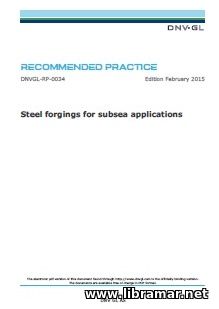 The present RP, i.e. recommended practice, by DNV class society contains all applicable criteria and technical requirements, as well as the necessary technical guidance on qualification, manufacture and subsequent testing of the forgings for the subsea applications, made of the carbon and low alloy steels. The document was intended for general application worldwide.
The applicable governmental regulations may include some requirements in excess of the provisions of this RP. The primary declared objectives of this document are to provide the harmonised standard for such steel forgings, that would be recognized internationally, help in reducing the lead time and enhancing the stock keeping, interchangeability of the forgings, simplify the process of the risk assessment, comply with the existing industry regulations for the subsea equipment and complement them in case of necessity, serve as a reference document to be in use when making contracts between the manufacturers and purchasers of the forgings, and as a good guide for designers, suppliers, buyers and regulators; in addition to the above stated objectives, this document is to assist in providing consistent quality and increase the reliability and overall integrity of the subsea equipment...
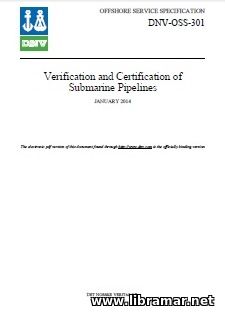 This OSS is intended to describe the verification service related to submarine pipelines and to define the additional DNV requirements for obtaining/retaining a DNV pipeline system Certificate of Conformity. This offshore specification falls under offshore specification DNV-OSS-300 "Risk Based Verification" considered the top-level document - and applies risk-differentiated levels of the involvement of verification activities; it is tailor-made for certification/verification of the pipeline systems that have been constructed and designed as per DNV-OS-F101. Based on the scope of work tables in Section 3, the detailed verification scope of work tables in Appendix D should be subject to project specific tailoring based on risk assessments.
The primary declared objectives of the present qualification procedure are to: describe DNV's verification and certification services for submarine pipeline systems, describe DNV's approach to risk differentiated levels of verification involvement, provide necessary guidance for the proper selection of the level of DNV verification involvement, and provide required guidance on how to establish a verification plan; in addition, it is intended to assist in creating common communication platform for describing the extent of verification activities required for DNV certification of submarine pipeline. The objective for the verification service is generally the verification of the pipeline integrity...
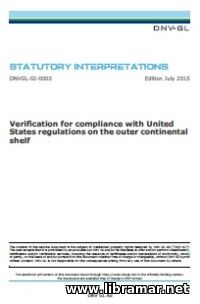 This is the service specification prepared and published by DNV-GL class society to outline the alternative regulatory roadmap for the operators and owners of the FOI (floating offshore installations), FSO (floating storage units) and FPSO (floating production, storage, and offloading units) willing to engage in OCS (outer continental shelf) activities in the Mexican Gulf.
It is based on the DNV-GL class rules and identifies the USCG requirements concerning design and equipment of such units not covered by these Rules. The specification provides a classification-based verification scheme for US compliance for the above stated types of offshore units. The first part of the specification provides general info on the principles and procedures for meeting the level of safety equivalent to the requirements of USCG, as well as legal provisions; the second part of the book provides applicable design and equipment requirements for same, consisting of the introductory part separate for each type of the unit, and compliance matrix.
There is also informative section describing the equivalencies and other design considerations, such as passive ballast systems, external impact load on hull, fire protection boundaries, platform verification program etc. The appendix contains the Policy Letter released by the USCG.
« 1 2 ... 16 17 18 19 20 ... 29 30 » |







